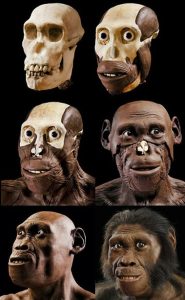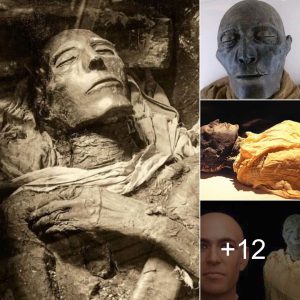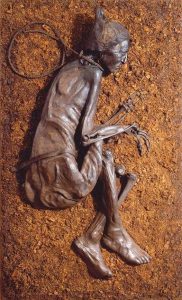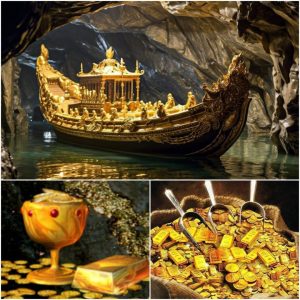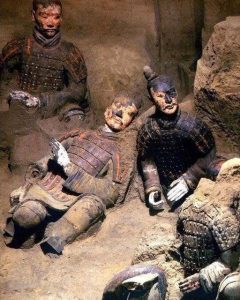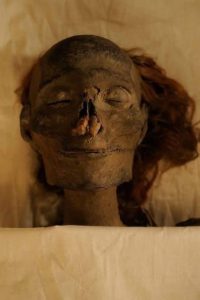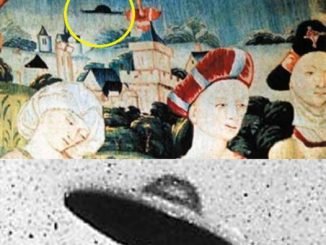Ancient Egyptians were embalming mummies 1,500 years earlier than first thought, new tests on a prehistoric corpse has confirmed
Tests on a prehistoric mummy reveal that ancient Egyptian embalming methods were in use 1,500 years earlier than previously thought.
The analysis was carried out on the ‘Turin Mummy’, which dates to between 3700BC and 3500BC and has been housed in the Egyptian Museum in Turin since 1901.
Unlike the majority of other prehistoric mummies in museums, it has never undergone any conservation treatments.
This provided researchers a unique opportunity for accurate scientific analysis of an preserved corpse which has not been tampered with since it was entombed.
Tests on a prehistoric mummy reveal that ancient Egyptian embalming methods were in use 1,500 years earlier than previously thought. This image shows the remains of a coffin containing the mummy in fetal position
Like its famous counterpart Gebelein Man A in the British Museum, the Turin mummy was previously assumed to have been naturally mummified by the desiccating action of the hot, dry desert sand.

Using chemical analysis, researchers uncovered evidence that the mummy had in fact undergone an embalming process.
This was done using plant oil, heated conifer resin, an aromatic plant extract and a plant gum and sugar mix.
This was wiped on the funerary textiles in which the body was wrapped.
The analysis was carried out on the ‘Turin Mummy’ (pictured), which dates to between 3700BC and 3500BC and has been housed in the Egyptian Museum in Turin since 1901
The ‘recipe’ contained antibacterial agents, used in similar proportions to those employed by the Egyptian embalmers when their skill was at its peak some 2,500 years later, according to the team.
The study builds on previous research from 2014 which first identified the presence of complex embalming agents in surviving fragments of linen wrappings from prehistoric bodies in now obliterated tombs at Mostagedda in Middle Egypt.
According to the team, which includes researchers from Oxford, York and Warwick Universities, the mummy came from Upper Egypt.
The body offers the first indication that the embalming recipe was being used over a wider geographical area at a time when the concept of a pan-Egyptian identity was supposedly still developing.
Unlike the majority of other prehistoric mummies in museums, the ‘Turin Mummy’ has never undergone any conservation treatments, providing a unique opportunity for accurate scientific analysis. Pictured is the mask of King Tutankhamun at the Egyptian Museum in Cairo
HOW DO BODIES BECOME NATURALLY MUMMIFIED?
Tollund Man (pictured), who lived in the fourth century BCE, is one of the best studied examples of a ‘bog body’
Natural mummification is defined as the process by which the skin and organs of a deceased person or animal are preserved, without the introduction of chemicals by humans.
It is rare, and only happens in specific situations.
These include: extreme cold, arid conditions, or a lack of oxygen.
Naturally preserved mummies have been found deposited in deserts, buried in oxygen-poor peat bogs, and frozen in glaciers.
Some ancient societies accidentally encouraged this process, as they would paint the bodies and cover the deceased person’s face in a mask.
This provided an impervious layer which allowed the process to take place.
Throughout the UK, bogs provide the perfect environment for this to happen.
Tollund Man, discovered in Denmark in 1950, is one of the best studied examples of a ‘bog body’.
The man, who lived in the fourth century BC, was so well-preserved that he was initially mistaken for a recent murder victim.
Having identified very similar embalming recipes in our previous research on prehistoric burials, this latest study provides both the first evidence for the wider geographical use of these balms and the first ever unequivocal scientific evidence for the use of embalming on an intact, prehistoric Egyptian mummy’, said Dr Stephen Buckley, an archaeological chemist and mummification expert of York University.
‘Moreover, this preservative treatment contained antibacterial constituents in the same proportions as those used in later “true” mummification.
‘As such, our findings represent the literal embodiment of the forerunners of classic mummification, which would become one of the central and iconic pillars of ancient Egyptian culture.’
Dr Jana Jones, an expert on ancient Egyptian burial practices of Macquarie University in Australia said the find was a ‘momentous contribution to our limited knowledge of the prehistoric period’.
She said it also provided ‘vital, new information on this particular mummy.’
The mummy of the mother of Egypt’s famed King Tutankhamun is displayed during a press conference. Dr Jana Jones, an expert on ancient Egyptian burial practices of Macquarie University in Australia said the find was a ‘ momentous contribution to our limited knowledge of the prehistoric period’
By combining chemical analysis with visual examination of the body, genetic investigations, radiocarbon dating and microscopic analysis of the linen wrappings, researchers also confirmed that the mummification took place around 3600 BC.
The individual was aged between 20 and 30 years when he died.
Professor Tom Higham, deputy director of Oxford radiocarbon accelerator unit, said: ‘There are very few mummies of this ‘natural’ type available for analysis.
‘Our radiocarbon dating shows it dates to the early Naqada phase of Egyptian prehistory, substantially earlier than the classic Pharaonic period, and this early age offers us an unparalleled glimpse into funerary treatment before the rise of the state.
‘The results change significantly our understanding of the development of mummification and the use of embalming agents and demonstrate the power of interdisciplinary science in understanding the past.’
WHO WAS HATSHEPSUT AND WHERE IS SHE BURIED?
Hatshepsut became queen of Egypt when she married her half-brother, Thutmose II, at the age of 12.
She was the elder of two daughters born to Thutmose I and his queen, Ahmes.
She took on the full powers of a pharaoh, becoming co-ruler of Egypt around 1473 BC.
Hatshepsut knew her rise to becoming pharoah was conterversial.
As a result, she attempted to reinvent her her image in statues and paintings.
For instance, she ordered that she be portrayed as a male pharaoh, with a beard and large muscles in many of them.
The modest resting place of Hatshepsut was discovered by Howard Carter, who famously revealed Tutankhamun’s grave.
Her mummy was one of a pair found inside – although that wasn’t obvious when they were first found.
Experts analysed a tooth known to belong to the queen to find it matched with the larger of the two mummies, suggesting the queen was obese with rotten teeth and pendulous breasts.
The modest resting place of Hatshepsut was discovered by Howard Carter, who famously revealed Tutankhamun’s grave. This mummy is thought to be that of her husband, Pharaoh Tuthomis II
Zahi Hawass, Egypt’s chief archaeologist, said in 2007 when the match was made: ‘This is the most important discovery in the Valley of the Kings since the discovery of King Tutankhamun and one of the greatest adventures of my life.
‘Queens, especially the great ones like Nefertiti and Cleopatra, capture our imaginations.
‘But it is perhaps Hatshepsut, who was both a king and a queen who was most fascinating.
‘Her reign during the 18th dynasty of ancient Egypt was a prosperous one, yet mysteriously she was erased from Egyptian history.’
READ MORE
This skull, wearing medieval chainmail, was discovered in a mass grave on the Island of Gotland, Sweden.
The mummy of King Tutankhamen, the famous Egyptian pharaoh, can be found in his tomb in the Valley of the Kings in Luxor, Egypt.
“Ginger,” one of the oldest existing Egyptian mummies, dates back over 5500 years.
Post Views: 1,053
Related







